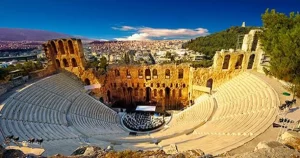Originally built by the Nabataeans (not the Romans) more than 2000 years ago, the Theatre was chiselled out of rock, slicing through many caves and tombs in the process. It was enlarged by the Romans to hold about 8500 (around 30% of the population of Petra) soon after they arrived in 106 CE. Badly damaged by an earthquake in 363 CE, the Theatre was partially dismantled to build other structures but it remains a Petra highlight.

The seating area had an original capacity of about 3000 in 45 rows of seats, with three horizontal sections separated by two corridors. The orchestra section was carved from the rock, but the backdrop to the frons scaenae (stage, which is no longer intact) was constructed, as opposed to carved, in three storeys with frescoed niches and columns overlaid by marble. The performers entered through one of three entrances, the outlines of which are still partially visible.

To make room for the upper seating tiers, the Romans sliced through more tombs. Under the stage floor were storerooms and a slot through which a curtain could be lowered at the start of a performance. From near the slot, an almost-complete statue of Hercules was recovered.

With a backdrop worthy of a David Roberts canvas, the Theatre now offers a vantage point from which to watch a modern tragicomedy of the ill-costumed, cursing their high-heeled footwear; the ill-cast, yawning at tedious tour guides; and the ill-tempered – mainly in the form of irritable camels and their peevish owners.


